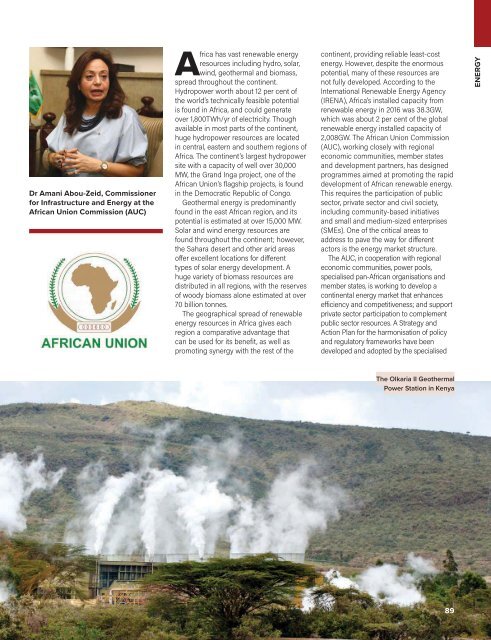Climate Action 2017-2018
Create successful ePaper yourself
Turn your PDF publications into a flip-book with our unique Google optimized e-Paper software.
Dr Amani Abou-Zeid, Commissioner<br />
for Infrastructure and Energy at the<br />
African Union Commission (AUC)<br />
Africa has vast renewable energy<br />
resources including hydro, solar,<br />
wind, geothermal and biomass,<br />
spread throughout the continent.<br />
Hydropower worth about 12 per cent of<br />
the world’s technically feasible potential<br />
is found in Africa, and could generate<br />
over 1,800TWh/yr of electricity. Though<br />
available in most parts of the continent,<br />
huge hydropower resources are located<br />
in central, eastern and southern regions of<br />
Africa. The continent’s largest hydropower<br />
site with a capacity of well over 30,000<br />
MW, the Grand Inga project, one of the<br />
African Union’s flagship projects, is found<br />
in the Democratic Republic of Congo.<br />
Geothermal energy is predominantly<br />
found in the east African region, and its<br />
potential is estimated at over 15,000 MW.<br />
Solar and wind energy resources are<br />
found throughout the continent; however,<br />
the Sahara desert and other arid areas<br />
off er excellent locations for diff erent<br />
types of solar energy development. A<br />
huge variety of biomass resources are<br />
distributed in all regions, with the reserves<br />
of woody biomass alone estimated at over<br />
70 billion tonnes.<br />
The geographical spread of renewable<br />
energy resources in Africa gives each<br />
region a comparative advantage that<br />
can be used for its benefit, as well as<br />
promoting synergy with the rest of the<br />
continent, providing reliable least-cost<br />
energy. However, despite the enormous<br />
potential, many of these resources are<br />
not fully developed. According to the<br />
International Renewable Energy Agency<br />
(IRENA), Africa’s installed capacity from<br />
renewable energy in 2016 was 38.3GW,<br />
which was about 2 per cent of the global<br />
renewable energy installed capacity of<br />
2,008GW. The African Union Commission<br />
(AUC), working closely with regional<br />
economic communities, member states<br />
and development partners, has designed<br />
programmes aimed at promoting the rapid<br />
development of African renewable energy.<br />
This requires the participation of public<br />
sector, private sector and civil society,<br />
including community-based initiatives<br />
and small and medium-sized enterprises<br />
(SMEs). One of the critical areas to<br />
address to pave the way for diff erent<br />
actors is the energy market structure.<br />
The AUC, in cooperation with regional<br />
economic communities, power pools,<br />
specialised pan-African organisations and<br />
member states, is working to develop a<br />
continental energy market that enhances<br />
eff iciency and competitiveness; and support<br />
private sector participation to complement<br />
public sector resources. A Strategy and<br />
<strong>Action</strong> Plan for the harmonisation of policy<br />
and regulatory frameworks have been<br />
developed and adopted by the specialised<br />
ENERGY<br />
The Olkaria II Geothermal<br />
Power Station in Kenya<br />
89












